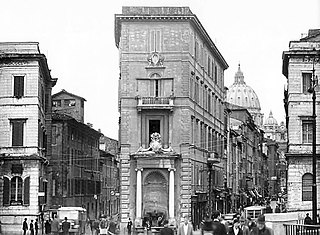
Year 848 (DCCCXLVIII) was a leap year starting on Sunday of the Julian calendar.

Pope Leo IV was the bishop of Rome and ruler of the Papal States from 10 April 847 to his death. He is remembered for repairing Roman churches that had been damaged during the Arab raid against Rome, and for building the Leonine Wall around Vatican Hill to protect the city. Pope Leo organized a league of Italian cities who fought and won the sea Battle of Ostia against the Saracens.
A prisoner in the Vatican or prisoner of the Vatican described the situation of the pope with respect to Italy during the period from the capture of Rome by the armed forces of the Kingdom of Italy on 20 September 1870 until the Lateran Treaty of 11 February 1929. Part of the process of Italian unification, the city's capture ended the millennium-old temporal rule of the popes over central Italy and allowed Rome to be designated the capital of the new nation. Although the Italians did not occupy the territories of Vatican Hill delimited by the Leonine walls and offered the creation of a city-state in the area, the popes from Pius IX to Pius XI refused the proposal and described themselves as prisoners of the new Italian state.

Saint Peter's Square is a large plaza located directly in front of St. Peter's Basilica in Vatican City, the papal enclave in Rome, directly west of the neighborhood (rione) of Borgo. Both the square and the basilica are named after Saint Peter, an apostle of Jesus whom Catholics consider to be the first Pope.

The Passetto di Borgo, or simply Passetto, is an elevated passage that links the Vatican City with the Castel Sant'Angelo. It is an approximately 800-metre-long (2,600 ft) corridor, located in the rione of Borgo. It was erected in 1277 by Pope Nicholas III, but parts of the wall were built by Totila during the Gothic War.

A rione of Rome is a traditional administrative division of the city of Rome. Rione is an Italian term used since the 14th century to name a district of a town. The term was born in Rome, originating from the administrative divisions of the city. The word comes from the Latin word regio, meaning "region"; during the Middle Ages the Latin word became rejones, from which rione comes. Currently, all the rioni are located in Municipio I of Rome.

Borgo is the 14th rione of Rome, Italy. It is identified by the initials R. XIV and is included within Municipio I.

Prati is the 22nd rione of Rome, identified by the initials R. XXII. It belongs to the Municipio I since 2013, while previously, along with Borgo and quartieri Trionfale and Della Vittoria, it was part of the Municipio XVII.
The Arab raid against Rome took place in 846. Muslim raiders plundered the outskirts of the city of Rome, sacking the basilicas of Old St Peter's and St Paul's-Outside-the-Walls, but were prevented from entering the city itself by the Aurelian Walls.

Via della Conciliazione is a street in the Rione of Borgo within Rome, Italy. Roughly 500 metres (1,600 ft) in length, it connects Saint Peter's Square to the Castel Sant'Angelo on the western bank of the Tiber River. The road was constructed between 1936 and 1950, and it is the primary access route to the Square. In addition to shops, it is bordered by a number of historical and religious buildings – including the Palazzo Torlonia, the Palazzo dei Penitenzieri and the Palazzo dei Convertendi, and the churches of Santa Maria in Traspontina and Santo Spirito in Sassia.

The Gardens of Vatican City, also informally known as the Vatican Gardens in Vatican City, are private urban gardens and parks which cover more than half of the country, located in the west of the territory and owned by the Pope. There are some buildings, such as Vatican Radio and the Governor's Palace, within the gardens.

The Church of Our Lady of Mercy in the Teutonic Cemetery is a Roman Catholic church in the rione Borgo of Rome, Italy. It is located on the Via della Sagrestia.
During the Middle Ages, Rome was divided into a number of administrative regions, usually numbering between twelve and fourteen, which changed over time.

The Church of San Pellegrino in Vaticano is an ancient Roman Catholic oratory in the Vatican City, located on the Via dei Pellegrini. The church is dedicated to Saint Peregrine of Auxerre, a Roman priest appointed by Pope Sixtus II who had suffered martyrdom in Gaul in the third century. It is one of the oldest churches in the Vatican City.

Porta Angelica was a gate of the Leonine Wall in Rome (Italy).

Porta Cavalleggeri was one of the gates of the Leonine Wall in Rome (Italy).

Porta Pertusa is one of the gates of the Leonine Wall in Rome (Italy).

Borgo Nuovo, originally known as via Alessandrina, also named via Recta or via Pontificum, was a road in the city of Rome, Italy, important for historical and architectural reasons. Built by Pope Alexander VI Borgia for the holy year of 1500, the road became one of the main centers of the high Renaissance in Rome. Borgo Nuovo was demolished together with the surrounding quarter in 1936–37 due to the construction of Via della Conciliazione.

Borgo Vecchio, also named in the Middle Ages Via Sancta, Carriera Sancta or Carriera Martyrum, was a road in the city of Rome, Italy, important for historical and architectural reasons. The road was destroyed together with the adjacent quartier in 1936–37 due to the construction of Via della Conciliazione.

San Michele Arcangelo ai Corridori di Borgo was a church in Rome dedicated to St. Michael, the Archangel, important for historical and artistic reasons.

















